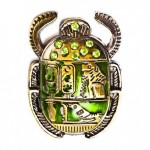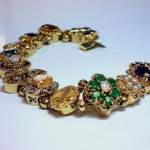Antique Chatelaines And Their History
The term “Chatelaine” is a French word that means keeper of the house and was originally used to describe a guard that kept the keys to a castle in the middle ages. Then in 17th century England they were historically worn by both men and women as a decorative ornament on which to hang small items commonly used in the household. Usually attached to a pocket or belt at the waist, they had chains with a swivel hook at the end of each to hang tools necessary to deal with problems that arose during the daily upkeep of the house. Some items typically found on a chatelaine are keys, a small notebook, pill bottles, eyeglasses, writing instruments, scissors, or a watch, to name a few.
In the 18th and 19th centuries they evolved into a type of functional jewelry item worn by the woman of the house throughout affluent European residences. They were a type of fashion accessory and viewed as a reflection of a family’s wealth, as much as a utilitarian instrument. The style of Chatelaines became more ornate and many times they were made of gold or sterling silver and decorated with gemstones or cameos. Some had elaborate repousse or enamel designs that depicted religious or nature scenes. Many jewelers saved their best efforts and designs to use on women’s chatelaines. They were often given as a wedding gift from a husband to his new wife.
The popularity of the chatelaine dwindled at the end of the 19th century as dresses with no waistline became popular and women didn’t have a place to attach one. The chatelaine was replaced with a brooch as a jewelry accessory and the functional use disappeared altogether.
These days you may see small sets of sewing notions fashioned together and called a chatelaine. Typically they include a small ornate pair of sewing scissors attached to a pin cushion with a long cloth tape measure. It’s intended to be worn by a seamstress around her neck so she has everything at her fingertips while sewing. The pin cushion may be decorated with a cross stitch or needlepoint pattern to customize it for the owner.
Antique chatelaines are becoming rare as many people have added them to collections. The best place to see fine examples of chatelaines is in history museums. They almost all have some sort of chatelaine as an example of historical family life. It’s fun to imagine the life of a household matriarch bustling through her day with her chatelaine jingling against her full skirts, stopping to trim the fray of a drapery or looking at the family finances through her magnifying glass.
If you’re looking to buy a chatelaine to start your own collection once in a while you can find a chatelaine on an auction site like ebay, but there are reproductions available too so make sure to do your homework before paying a premium price for a real antique. And of course antique fairs are another place to visit if you are interested in buying or even just to look. Chatelaines represent a piece of our ancestors’ past and have sentimental value whether they are made of gem encrusted gold, or a simple brass design.

More from my site
Category: All About Old Jewelry










Thank you so much for this information! I have one of these and it’s definately antique. It has remnants of enamel on it and the craftsmanship is unbelievable. I can’t tell if its brass or gold…I don’t believe it was ever silver plated.
It’s fantastic and I am glad to have learned a bit about it.
Also, I AGREE completely about the Silver Meltdown! It’s heartbreaking!! People are selling their vintage heirlooms for next to nothing and the craftsmanship can never be duplicated. So sad.
Thanks so much!!